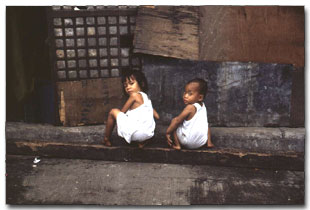|
|||||||||||||
TONDO URBAN DEVELOPMENT PROJECTExample of: • Participatory Development |
|||||||||||||
 |
Manila, Philippines |
||||||||||||
|
|
|||||||||||||
|
Summary
|
This urban development project took place in the Tondo Foreshore, the largest and most politically volatile slum in Manila and one of the largest in Asia with over 180,000 people. After having tried several small-scale resettlement plans, the city decided to implement an upgrading program instead, for a less disruptive and lower-cost solution to the problem. The program represents an efficient approach to housing/servicing problems in that it proved to be less disruptive than resettlement and it cost one quarter the price of a “low-cost” home in a resettlement area. The slum community virtually transformed itself over ten years into an upwardly mobile neighborhood without appearing to have evicted the truly poor. Tondo reaffirmed the assumption that if given security of tenure and basic services, families will build their own housing, the quality of which surpassed even the most optimistic predictions. Tondo residents were active participants in upgrading and became property owners with a stake in stability. The cost of this nine year World Bank project was estimated at P 488 (US$65) million but by project completion the actual cost was P 974 (US$92) million - a 100% peso increase and a 40% dollar increase. |
||||||||||||
|
For further information:
|
|||||||||||||
|
|
|||||||||||||
|
Objectives
|
|||||||||||||
|
Components
|
|||||||||||||
|
Lessons:
What worked and why? |
Upgrading in Tondo was a highly ambitious goal that was successfully achieved in physical and social terms.
|
||||||||||||

Manila, Philippines.
|
|||||||||||||
|
What didn't work and why?
|
The project was anticipated to last four years, but it actually took nine. A large increase in cost occurred due to delays associated with the massive size, complexity, and experimental nature of the project. Delays were associated with project start-up, higher than expected land acquisition and reclamation costs, petroleum price increases, and a lack of detailed design and engineering on major civil work at appraisal. Cost recovery was the weakest element of this project. Land and infrastructure costs were to be paid through mortgages but the lot price was set prematurely at P 95/sq. m. Four years later when completed, the actual cost had risen threefold. In fact, 90% of the residents could have afforded the real cost of P 300 but instead only paid the P 95 and the rest was subsidized. Cross subsidies from commercial/industrial sales produced disappointing results because 1. the Philippine economy had declined over the course of the project, eroding the prices of commercial/industrial lots; 2. the government agencies failed to make payments; and 3. the amount of land available for sale shrank by 20%. At completion, unit development costs were four times higher in terms of the peso due to the lack of cross subsidy funds. The handing over of completed infrastructure to city agencies proved difficult because legal agreements were vague and construction delays held up turnover. |
||||||||||||
|
Tips:
|
|||||||||||||
|
To Learn More:
|
|||||||||||||
|
|||||||||||||
